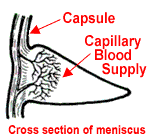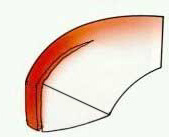Traumatic Meniscus Tears
A meniscus that is forcefully pinched between the femur and tibia
during a knee sprain injury may tear, even if it is strong, youthful
and undegenerated. Such tears are called "traumatic"
because they occur suddenly and because the meniscus would not
have failed at that time were it not for the highly stressful
knee sprain. With few exceptions, simultaneous weight-bearing
and joint rotation (as are typically seen in a wrenching, sprain-type
injury) are required to tear a meniscus, as without the former,
no impingement ("pinching") forces are experienced by
the meniscus.
 |
FIGURE
2 - Schematic diagram demonstrating the vascular (blood
vessel) supply of the meniscus, which enters through the meniscus'
attachment to the knee's capsular ligament. |
Only the outer (more peripheral) 30-40% of a meniscus actually
has a capillary blood supply (see FIGURE
2) and thereby a significant potential for healing when
injured. Sometimes a traumatic tear will involve this peripheral,
vascular (or so-called "red") zone of the meniscus,
whereas at other times it will also (or only) involve the avascular
(non-bleeding or so-called "white") zone, which is in
the inner 2/3 of the meniscus (see FIGURE
3). Relatively vertical (straight split), traumatic tears
in the peripheral 1/3 of the meniscus have good healing potential,
thus are almost always surgically repairable. Tears in the inner,
avascular "white" zone of the meniscus do not bleed
and are rarely good candidates for surgical repair (at least with
current technology), as their healing potential is much more limited.
Even if such tears seem to heal initially, following a repair
procedure, they have a fairly high chance of breaking down again,
thus requiring another surgical procedure (meniscectomy) to excise
them in the future.
 |
FIGURE
3 - Diagrammatic representation of a torn meniscus
(a so-called peripheral, longitudinal tear), seen in cross-section.
The "tear" is the curved, split-defect that you
see in between the peripheral red zone and the inner white
zone. The peripheral red zone in the outer 1/3 of the meniscus
is the only portion of the meniscus that has a capillary blood
supply (see Figure 2). Traumatic meniscal tears within or
at the edge of this vascular zone will bleed and thereby have
the potential to heal if treated properly, so they should
be repaired whenever possible. Tears in the inner, thinner,
avascular (white) zone do not bleed and have a far lesser
potential for stable healing. They are, therefore, significantly
less amenable to repair. This is true even if the meniscal
tissue was healthy and non-degenerated prior to failing. |
|



